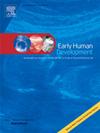Diet, growth, nutritional status and predictors of severity of feeding difficulties in autistic children with co-occurring pediatric feeding disorder
IF 2.2
3区 医学
Q2 OBSTETRICS & GYNECOLOGY
引用次数: 0
Abstract
Background
Feeding difficulties are commonly reported in autistic children. However, there is limited data on the presentation, severity, and impact of feeding difficulties in autistic children in Asia.
Aims
To describe the dietary patterns, growth and nutritional status of autistic children with pediatric feeding disorder (PFD), and identify factors associated with more severe feeding difficulties.
Study design
A retrospective review of electronic medical records.
Subjects
Autistic children (aged between 0 and 18 years) with PFD, who attended a multidisciplinary feeding clinic between August 2013 and December 2022.
Outcome measures
The children's parents provided a 3-day food diary, which was verified by the dietitian and analyzed for their nutritional content using Foodworks 10 Professional. Food selectivity was classified as mild, moderate or severe, based on the number of food groups accepted and the absolute number of foods accepted in each group. Information regarding demographics, height, weight, medical information, developmental history (autism diagnosis, cognition, adaptive skills) and relevant nutritional bloodwork were collected. Parents also completed two validated questionnaires (the Behavioral Pediatrics Feeding Assessment Scale (BPFAS), which assessed childhood mealtime behaviors; and the Caregiver Feeding Style Questionnaire (CFSQ), which determined caregiver/ parental feeding styles). Factors associated with higher BPFAS total frequency scores (TFS) (representing more severe feeding difficulties) and food selectivity were analyzed.
Results
There were a total of 98 patients (82 males), with mean ± SD (range) age of 59.2 ± 27.5 (17–169) months. They had mild (19.4 %), moderate (22.4 %) and severe (58.2 %) food selectivity, respectively. While the majority had normal weight (84.7 %) and height (88.8 %) for age, 69.4 % had diets deficient in calories, macronutrients or micronutrients (iron, calcium). Comparison between groups according to parental feeding style found that there was a significant difference in BFPAS TFS between different parental feeding styles (p < 0.001). Post-hoc testing revealed that parents who reported an authoritarian parental feeding style on the CFSQ were significantly more likely to report higher frequencies of difficult feeding behaviors on the BPFAS (98.3 ± 15.8), while an uninvolved parental feeding style was associated with the lowest BPFAS TFS (80.9 ± 11.0), Bonferroni-adjusted p < 0.001; indulgent (p = 0.012) and authoritative (p = 0.096). Intellectual impairment and Malay ethnicity were associated with more severe food selectivity [adjusted odds ratio 123.7 (95 % CI 3.09–4945.4, p = 0.01) and 38.0 (95 % CI 1.35–1074.18, p = 0.03)], respectively.
Conclusions
In this retrospective cohort, autistic children with PFD were at significant nutritional risk despite demonstrating normal growth patterns, with specific patient profiles being associated with more severe feeding difficulties.
伴有小儿喂养障碍的自闭症儿童的饮食、发育、营养状况以及喂养困难严重程度的预测因素
背景自闭症儿童普遍存在喂养困难。目的 描述患有小儿喂养障碍(PFD)的自闭症儿童的饮食模式、生长和营养状况,并确定与较严重喂养障碍相关的因素。研究对象2013年8月至2022年12月期间在多学科喂养门诊就诊的患有小儿喂养障碍的自闭症儿童(0至18岁)。结果测量儿童的父母提供了3天的食物日记,营养师对其进行了核实,并使用Foodworks 10 Professional对其营养成分进行了分析。根据接受的食物组别数量和每组中接受食物的绝对数量,将食物选择性分为轻度、中度和重度。收集的信息包括人口统计学、身高、体重、医疗信息、发育史(自闭症诊断、认知、适应能力)以及相关的营养血检。家长们还填写了两份经过验证的问卷(儿科喂养行为评估量表(BPFAS),用于评估儿童进餐时的行为;照顾者喂养方式问卷(CFSQ),用于确定照顾者/家长的喂养方式)。结果共有 98 名患者(82 名男性),平均年龄为 59.2 ± 27.5(17-169)个月,平均±标准差(范围)为 59.2 ± 27.5(17-169)个月。他们的食物选择性分别为轻度(19.4%)、中度(22.4%)和重度(58.2%)。虽然大多数儿童的体重(84.7%)和身高(88.8%)与年龄相符,但69.4%的儿童饮食中热量、宏量营养素或微量营养素(铁、钙)不足。根据父母喂养方式进行的组间比较发现,不同父母喂养方式的 BFPAS TFS 有显著差异(p <0.001)。事后检验显示,在CFSQ中报告父母喂养方式为专制型的父母,在BPFAS中报告喂养困难行为频率较高的可能性明显更大(98.3 ± 15.8),而父母喂养方式为不参与型的父母,其BPFAS TFS(80.9 ± 11.0)最低,经Bonferroni调整后,p < 0.001;溺爱型(p = 0.012)和专制型(p = 0.096)的父母,其BPFAS TFS(80.9 ± 11.0)最低。结论在这一回顾性队列中,患有PFD的自闭症儿童尽管显示出正常的生长模式,但却面临着巨大的营养风险,特定的患者特征与更严重的喂养困难有关。
本文章由计算机程序翻译,如有差异,请以英文原文为准。
求助全文
约1分钟内获得全文
求助全文
来源期刊

Early human development
医学-妇产科学
CiteScore
4.40
自引率
4.00%
发文量
100
审稿时长
46 days
期刊介绍:
Established as an authoritative, highly cited voice on early human development, Early Human Development provides a unique opportunity for researchers and clinicians to bridge the communication gap between disciplines. Creating a forum for the productive exchange of ideas concerning early human growth and development, the journal publishes original research and clinical papers with particular emphasis on the continuum between fetal life and the perinatal period; aspects of postnatal growth influenced by early events; and the safeguarding of the quality of human survival.
The first comprehensive and interdisciplinary journal in this area of growing importance, Early Human Development offers pertinent contributions to the following subject areas:
Fetology; perinatology; pediatrics; growth and development; obstetrics; reproduction and fertility; epidemiology; behavioural sciences; nutrition and metabolism; teratology; neurology; brain biology; developmental psychology and screening.
 求助内容:
求助内容: 应助结果提醒方式:
应助结果提醒方式:


